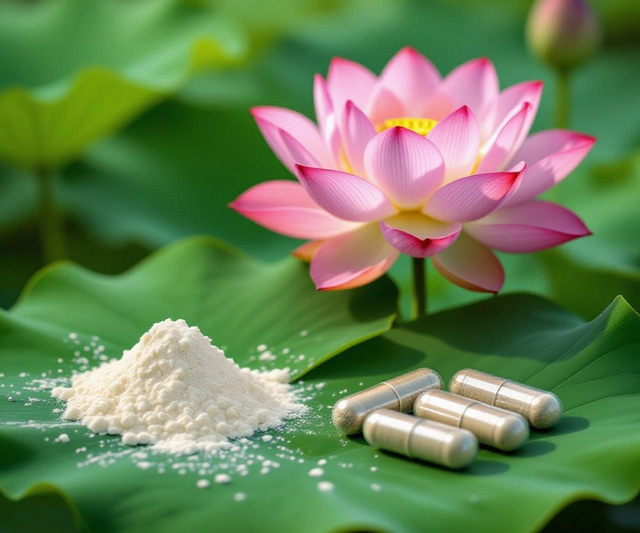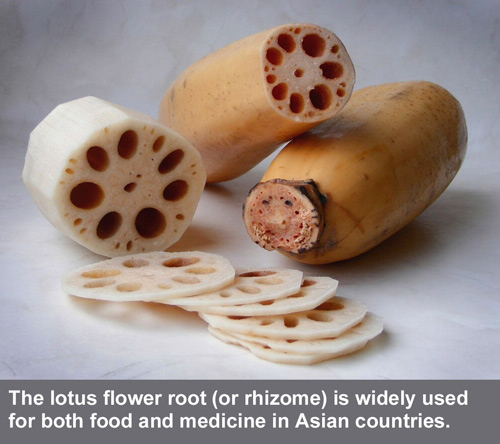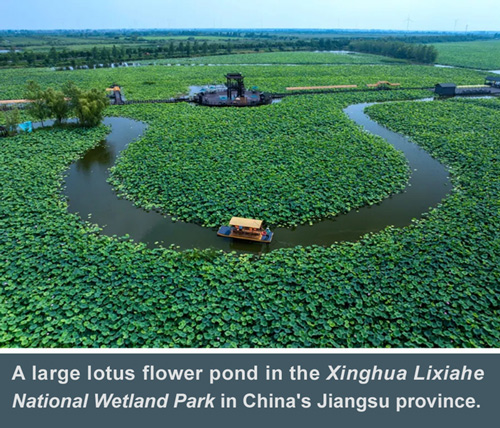Most people recognize the lotus flower (Nelumbo nucifera) due to it’s symbolic representation in both current and ancient religions.
It was an omnipresent feature in ancient Egypt, and today it is still prominent in Hinduism and Buddhism in India, China and Japan. After the introduction of Christianity in Asia, the lotus flower was even “Christianized” and added to paintings, reliefs and sculptures of the Catholic church—where it still has a presence today.
According to JustAPedia, “In the classical written and oral literature of many Asian cultures the lotus is present in figurative form, representing elegance, beauty, perfection, purity and grace, being often used in poems and songs as an allegory for ideal feminine attributes.”
Far less recognized, however, is the history of lotus flowers as food, medicine and nutritional support. These uses are so integrated in Asian cultures that some countries—India and Vietnam—elevate Nelumbo nucifera to national flower status.
All parts of lotus flowers are used for food—with the rhizome be the most utilized, followed by the seeds.
Medicinal use
For historical medicinal used, it is the rhizomes, leaves and seeds that have recorded uses dating back at least 3,000 years. This includes widespread use in the traditional medicine system from India, known as Ayurveda; and in the Traditional Chinese Medicine system from China.
Lotus flower also has a long history in Oriental Medicine. Oriental Medicine is often confused with Traditional Chinese Medicine, but it actually encompasses a wider range of practices such as Tibetan, Korean and Japanese medicine.
While differences are present in the varied systems, the leaves of lotus flower are commonly used for hematemesis, nosebleed and hematuria (blood in urine). The flowers are used for lowering blood sugar levels, diarrhea, cholera, fever and hyperdipsia (intense thirst).
Meanwhile the rhizomes were traditionally used for diuretic properties—and today are recognized for their antidiabetic and anti-inflammatory properties.
As early as the Han Dynasty, lotus seeds were already recorded as an astringent, nourishing the heart and supporting the kidneys in Shen Nong’s Herbal Classic. Today there are 22 varieties for the four known Chinese lines, which are found particularly in Jianning (still called “the town of Jianlian lotus seeds in China”) and Guangchang (“the town of white lotus seeds in China”).
Today the perennial aquatic herb is gaining a “trifecta” of popularity worldwide: food, nutraceutical and historical/cultural icon.
In recognition of lotus flower’s special role in human health the Chinese Ministry of Health approved the use of lotus flowers as both “food and medicine.”
The Chinese Herbal Dictionary, lists lotus flower with the pharmaceutical name Folium Nelumbinis, and assigns it to the “Medica Category” of Heat-clearing and Toxin-eliminating Herbs.
Natural water filtration
The same constituents of Nelumbo nucifera that facilitate toxin removal in the human body are also being studied as a natural water filtration tool. In a process known as “rhizofiltration” the herb has shown great potential for usage in wastewater treatment—removing polluting compounds and heavy metals.
Various studies also show the successful use of Nelumbo nucifera for counteracting water eutrophication—or high mineral content. The results observed in one study showed 96% of copper and 85% cadmium metals removed after a seven-day incubation period.
Food use
The rhizomes of lotus are consumed as a vegetable in Asian countries—especially in China, Japan and India. Lotus is sold whole or in cut pieces. Traditionally it was always fresh, but today it is also available frozen or canned in many areas.
Lotus is mostly fried or boiled in soups, but is also soaked in syrup or pickled in vinegar. Lotus rhizomes have a crunchy texture with sweet-tangy flavors and are a classic dish at many banquets, where they are deep-fried, stir-fried, or stuffed with meats or preserved fruits.
Lotus is so popular in Japan that the country must import 18,000 tons of rhizome each year to compliment its extensive domestic production.
Rhizomes contain high amounts of starch (31.2%) without characteristic taste or odor. The texture is comparable to a raw potato.
The binding and disintegration properties of isolated lotus starch have been compared with maize and potato starch. In fact, lotus starch is shown to be superior as an adjuvant in the preparation of pharmaceutical and supplement tablets. When dried, Nelumbo nucifera is also made into flour—another popular use of the vegetable in Asia.
Recent studies highlight versatility as both food and medicine
Recent studies have highlighted all aspects of lotus flower cultivation, recognizing it as both a nutrient dense food, and as a widely-used nutraceutical—at least in Asia.
• A 2022 review published in The American Journal of Chinese Medicine analyzed current literature on lotus flower and concluded “modern evidence for the traditional uses are abundant and substantiate traditional uses.” The review, aptly named “Research Advances in Lotus Leaf as Chinese Dietary Herbal Medicine,” included citations for dozens of studies.
According to the authors of the study: “The extracts and active components of Heye (Chinese name for lotus flower) demonstrate multiple bioactivities, for instance anti-obesity, anti-inflammatory, anti-oxidant, cardiovascular protective, anticancer, hepatoprotective, hypoglycemic, antiviral, antimicrobial, as well as hemostatic activities.”
• A review published in Applied Food Research in June 2023 included a summary of dozens of studies, earlier reviews and white papers to document the benefits of lotus both as food and medicine.
The study, entitled Review on edible water lilies and lotus–Future food, nutrition and their health benefits, summarized research on all facets of lotus flower, from economical superfood to extensive medical applications:
“Water liles and lotus have known to contain good source of protein, dietary fiber, carbohydrate, amino acids, fatty acids, vitamins, minerals and phytochemicals that have health importance.
“More than 150 compounds have been identified from rhizome, seed, leaf, stem, flower and seed of water lilies and lotus. The in vitro and in vivo studies indicate water lilies and lotus are promising medicinal plants. It can be suggested that these edible aquatic plants could be commercially cultivated, harvested and processed to feed the increasing human population.”
– – –
Lotus flower (leaf powder) can be found in Opti-Lung from Optimal Health Systems. Click on the banner ad on this page to learn more.
– – –
Sources: JustAPedia.org, HealthFactsTime.com, ChineseHerbalDictionary.com, Journal of the Human Environment, The American Journal of Chinese Medicine, Applied Food Research.




